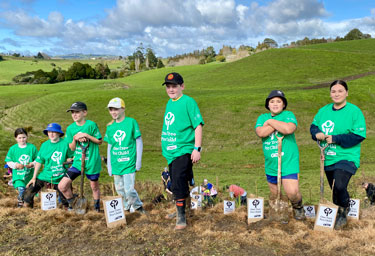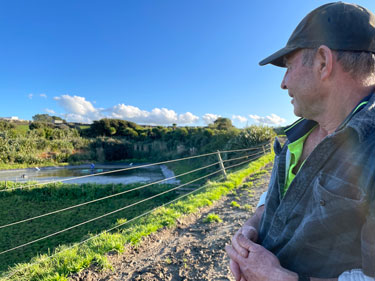Future forests
In revitalised habitats all over the country, biodiversity is thriving with more birdsong and cleaner waterways. Native seedlings grown and planted by school children over the last few decades are quietly growing into forests.
Trees for Survival Charitable Trust began in Auckland in 1991 with a simple shade house and a plan to inspire children how to grow, nurture and plant native seedlings for the protection of at-risk land across Aotearoa.
Thinking globally but acting locally is the focus of Trees for Survival, with many businesses keen to show their support for their community and see the results of the program. Now in its 33rd year, and celebrating over two million native plants in the ground, Trees for Survival has big goals for the future: to grow their community and corporate partnerships with a vision to take their education program to more regions and more schools.
Lending its support, an international initiative was launched in New Zealand this winter. One Tree Per Child was brought to New Zealand with the support of Yates. It was founded by Olivia Newton-John and Jon Dee 11 years ago to encourage every child to plant at least one tree before they leave school.
New Zealand is the 11th country to sign up. “Bringing One Tree Per Child to New Zealand and partnering with Trees for Survival will increase the numbers of trees planted,” says Yates spokesperson Fiona Arthur. “As their trees grow, we hope to inspire the children to deepen their dedication to safeguarding and nurturing Aotearoa’s environment and wildlife.”
Trees for Survival Business Development Manager, Sally Clegg, welcomes the support and additional funding that One Tree Per Child will bring. “We have a waiting list of 120 schools wanting to join our program and we can’t reach everybody on current levels of funding so we’re delighted to partner with One Tree Per Child to get more native trees and shrubs in the ground.”
Trees for Survival partners with schools and landowners around the country in an environmental education program that helps schools to grow and plant native trees where they are most needed to protect streams, wetlands and erosion-prone land.
The first tree project for the new alliance is on the property of Patumahoe dairy farmer, Brian Gallagher. Brian and his family have been on the land for three generations and they currently have 400 dairy cows providing fresh milk for Aucklanders every day.
Brian has partnered with Trees for Survival for 10 years, carrying out planting projects around the farm that have made a significant difference to the waterways and biodiversity.
Tree planting along waterways can significantly improve water quality. The plants act as a filter and stabiliser, decreasing erosion as well as sediment and nutrient run-off, leading to cleaner streams and rivers.
What started out as curiosity around 12 years ago has turned Brian into an enthusiastic tree planter and a proponent of providing school children with environmental education on the land.
“Tree planting has become a bit of a bug. I initially planted up some land around a new effluent storage pond, at the suggestion of Auckland City Council, and since then I haven’t stopped looking for new places to plant.
“Thanks to Trees for Survival we’ve planted around the boundary of the property and about one kilometre of waterways. This next project is planting natives on land that had pine trees on it.”
The trees and shrubs will not only help improve water quality but will also encourage new birdlife, insects and invertebrates into the area and provide shade and shelter for Brian’s cows. Seeds of manuka, kanuka, flax, cabbage tree and grasses have all been locally eco-sourced by specialist seed collectors, germinated at nurseries and potted on and grown into seedlings by partner school, Patumahoe Primary School. The 760 seedlings, grown by the students, were planted on Gallaghers property by the children and local community this August.
Fiona said the collaboration with One Tree per Child and Trees for Survival not only supports the planting of more trees but provides an additional opportunity for children to learn about growing and caring for plants.
“Being involved in the whole growing cycle helps children understand what it takes to plant a tree. It’s not just about digging a hole in the ground but setting up each seedling for success and watching that seedling grow into a healthy mature plant or tree.”
Find out more at Trees for Survival tfsnz.org.nz and OneTreePerChild.com
1-Sep-2024

Patumahoe Primary School children enjoy their planting day on Brian Gallagher's farm, in August

Dairy farmer Brian Gallagher looks over a now vibrant native habitat which was planted by local school children 12 years ago.


